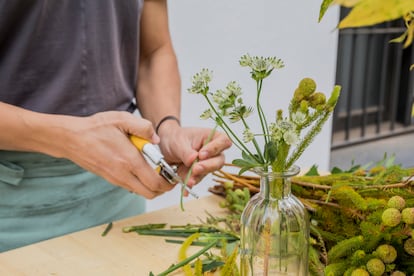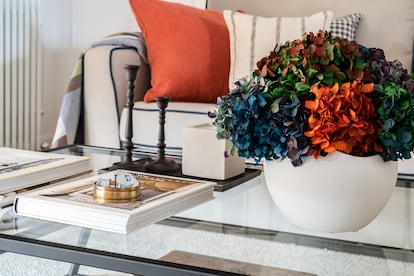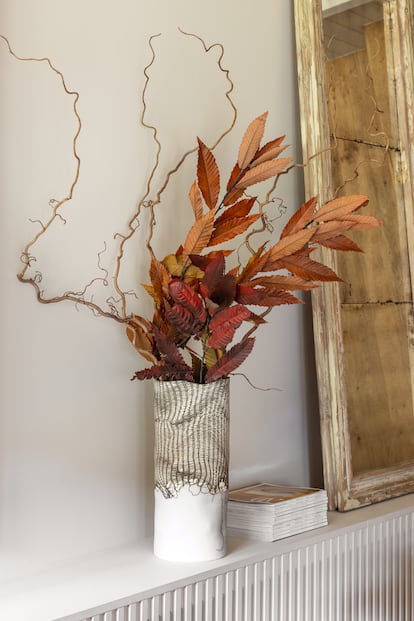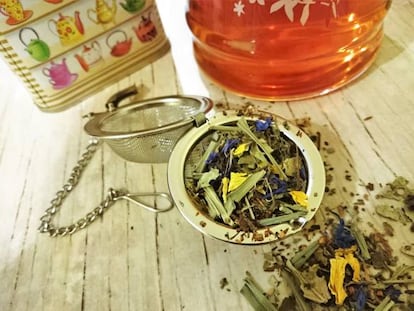Preserved plants: Why they are trending, how to care for them and how long they last
The preservation process extends the life of bouquets, flowers, buds and leaves. They are similar to fresh bouquets in that they are soft, colorful, flexible and lightly scented, but have the advantage of offering decoration for years without needing water and requiring only minimal maintenance

Is forever a long time? If we are talking about natural plants, then the answer is definitely yes. Cut flowers are a mirage of life, a fleeting delight, the chronicle of a death foretold. No matter the type, origin, hardiness or price we have paid for them, in just a week or two at best, a bouquet of flowers will grow increasingly brown, fragile, sad and decadent, until it becomes a shell of what it once was. In the end, there will be no trace of color, flexibility, delicacy or movement.
In terms of the emotions they arouse, the sensations they stimulate and their evocative power, nothing compares to fresh flowers. Their ephemeral life is precisely what makes them unique and inimitable. But there may be sentimental or practical reasons why we want to perpetuate their survival beyond what nature allows. A bridal bouquet, a meaningful bouquet, a bouquet that celebrates a birth... There is the option of drying or pressing the flowers, but if you are seeking to enjoy the ornamental presence of flowers that look fresh — ductile, soft, malleable, with a satiny appearance and even a faint whisper of their original scent — preservation is the perfect solution.
The preservation process is an increasingly advanced and perfected technique that makes it possible to stop time when natural plants are in their full splendor. Unlike drying, which consists strictly of removing the water from a natural plant, preserved plants are “fresh plants whose sap has been extracted at their peak and replaced by a liquid preservative,” says Samar Cajal, the creative designer and co-founder of Sakura Atelier in Madrid, Spain. To perpetuate the appearance of a living flower with maximum realism and magnificence, the process of preserving the plant begins a few days before its prime, since during the preservation process, it will continue to age (e.g., if it is a flower, the bud will continue to open). From the perspective of sustainability, the ideal moisturizing fluid for infiltrating the sap site is biodegradable and made from plants, like vegetable glycerin; that’s what they do at Sakura Atelier. Through its tissues, the plant absorbs the viscous organic compound, which retains moisture, preserves and extends the life of branches, flowers, buds and leaves.

Because of their longevity, preserved plants have become popular commercially and often have names such as “eternal” or “perpetual.” Some manufacturers state that the plants’ lives can be extended between three and five years in an optimal environment; even that timeframe can be extended indefinitely if the bouquet is kept in specific conditions. “They need minimal care,” Cajal explains. “The basics are protecting them from direct sunlight so that the color does not degrade; keeping them away from heating, air conditioning and radiators so they don’t dry out; protecting them from contact with water and humidity; and remembering to dust them from time to time.” At the Sakura Atelier studio, they do this by gently blowing cold air on the preserved flowers with a blow-dryer. Cajal notes that “if [the preserved flowers] are properly maintained, they should not defoliate or lose petals.”

Although they will never be as subtle as a fresh natural plant, preserved ones offer great results and are perfect for decorating commercial premises, restaurants, professional studios and establishments where time or budget constraints do not allow for replacing fresh flower arrangements each week. Of course, you will have to choose from a smaller catalog than the fresh ones that nature offers; not all flowers and plants can be preserved. Roses, chrysanthemums, daisies, orchids, hydrangeas, gerberas, baby’s breath and lavender are the most commonly preserved ones. ”The best flowers and plants for this technique are those that have a hard, woody stem that can withstand the sap extraction process without breaking,” says Cajal.
Because of their extreme fragility and the small size of their stems, some flowers cannot be preserved, like poppies, buttercups and tulips. Among the greens — as all non-flowering foliage used in floristry to provide volume, texture and chromatic background to the arrangements are known — eucalyptus, asparagus, ferns and ruscus offer the greatest advantages. In fact, the persistence of an aroma after preservation is one of the benefits of certain greens such as eucalyptus. For plants that do not retain their fragrance, “one trick is to add a drop of botanical essential oil,” Cajal suggests. The plants themselves will act as a diffuser by exhaling a soft aroma.

If we want to remove our preserved plants from a decoration and then use them again months later, the Sakura Atelier team says that it’s ideal to store them hanging upside down, so they don’t get crushed on either side. Because that’s not always possible, Cajal recommends “dusting them, wrapping them in tissue paper or a soft cotton muslin cloth and placing them in a box big enough to contain them without being tight or crushing them.” When we take the preserved flowers out again, all we have to do is gently shake them to loosen them up and help them recover their elegance.
People tend to think of dried or preserved flowers as environmentally friendly, but that’s not always the case. As Cajal explains, “if we define green as having a low carbon footprint, plants processed in this way are very green because they are reused for years and do not permanently generate waste streams, but green and sustainability are not defined by carbon footprint alone.” We must know where the product we’re buying comes from and the processes it has undergone. Cajal adds that “to be truly environmentally friendly, this means that the preservatives used must be chemical-free; no plastic-based sealants or artificial colorants should be applied [to the plants]; and the whole process should be ethically sustainable.” While they are not the same as fresh flowers, preserved plants won’t wilt like them either.
Sign up for our weekly newsletter to get more English-language news coverage from EL PAÍS USA Edition
Tu suscripción se está usando en otro dispositivo
¿Quieres añadir otro usuario a tu suscripción?
Si continúas leyendo en este dispositivo, no se podrá leer en el otro.
FlechaTu suscripción se está usando en otro dispositivo y solo puedes acceder a EL PAÍS desde un dispositivo a la vez.
Si quieres compartir tu cuenta, cambia tu suscripción a la modalidad Premium, así podrás añadir otro usuario. Cada uno accederá con su propia cuenta de email, lo que os permitirá personalizar vuestra experiencia en EL PAÍS.
¿Tienes una suscripción de empresa? Accede aquí para contratar más cuentas.
En el caso de no saber quién está usando tu cuenta, te recomendamos cambiar tu contraseña aquí.
Si decides continuar compartiendo tu cuenta, este mensaje se mostrará en tu dispositivo y en el de la otra persona que está usando tu cuenta de forma indefinida, afectando a tu experiencia de lectura. Puedes consultar aquí los términos y condiciones de la suscripción digital.
More information
Últimas noticias
Tiger Woods turns 50: Will he continue playing on the PGA Tour or take a back seat?
The surreal journey of James Nnaji, the Barcelona youth player selected in the NBA Draft who ended up in the NCAA
Trump claims peace in Ukraine is near, but Moscow suggests otherwise
A survivor’s account of the Interoceanic Train accident: ‘We were scared because of the speed on the curve’
Most viewed
- Oona Chaplin: ‘I told James Cameron that I was living in a treehouse and starting a permaculture project with a friend’
- Reinhard Genzel, Nobel laureate in physics: ‘One-minute videos will never give you the truth’
- Why the price of coffee has skyrocketed: from Brazilian plantations to specialty coffee houses
- Pablo Escobar’s hippos: A serious environmental problem, 40 years on
- Chevy Chase, the beloved comedian who was a monster off camera: ‘Not everyone hated him, just the people who’ve worked with him’










































